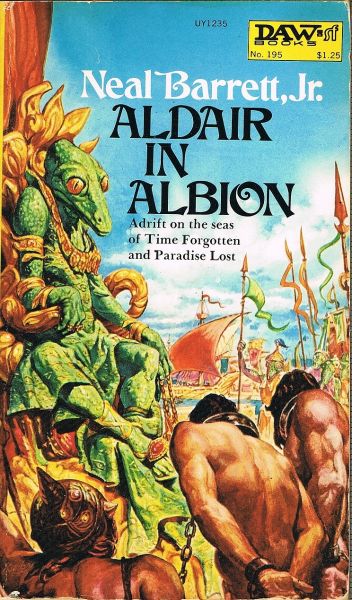When in Rome
Aldair in Albion (Aldair, volume 1)
By Neal Barrett, Jr.

12 Dec, 2021
Because My Tears Are Delicious To You
0 comments
1976’s Aldair in Albion is the first volume in Neal Barrett, Jr.’s Aldair science fiction quartet.
Aldair of clan Venicii could have enjoyed the conventional life of his Gaullian people: raising crops and children and fighting off the Stygianns. He would also have ignored the Rhemian conviction that their empire includes Gaullia (easy to ignore because Rhemians don’t care to visit that distant barbarian land). But Aldair doesn’t ignore the Rhemians: he travels to attend a Rheimian college in Silium, where he studies under Master Levitinus.
Whim leads Aldair to converse briefly with a Stygiann prisoner named Rheif. It’s a decision Aldair will regret.
Angry at being disciplined for misbehavior, spoiled student Flavius frames Master Levitinus for heresy; the accusation includes Aldair as well. Now master and student are both wanted by the Church. Aldair is of particular interest due to his conversation with the now-escaped Stygiann. Master Levitinus is beheaded. Aldair flees.
Hiding in a boat long enough to sleep, Aldair wakes to discover his Stygiann acquaintance Rheif in the middle of stealing the boat1. Back home, Stygianns see Aldair’s kind as delicious but uncooperative food, while Stygianns are to Aldair the stuff that fine, fur-covered boots are made of. The fugitives set aside ancient enmity in favour of an alliance of convenience.
Gaullia is north. The Stygiann homeland is even further north. The empire, whose resources include great, lumbering ships, will no doubt expect Aldair and his allies to head north. Seeking to avoid the methodical, thorough Rheimians, Aldair guides the boat south, through the straits leading to the Southern Sea and into the Sea itself. This bold strategy is partially successful. Aldair and Rheif are not captured by Rheimians. They are captured by the scaly, cold-blooded Nicieans who rule south of the Southern Sea.
It happens that the Nicieans happen on the fugitives just as Rheif is attempting to capture and eat a young Niciean. The youth in question is the son of the Niciean King. While the Nicieans officially eschew the death penalty, they are quite adept at finding ways to circumvent the ban. Very luckily for the two fugitives, the Nicieans misunderstand how the prince came to be in Rheif’s clutches. Thus, the pair are welcomed by the boy’s uncle Lord Tharrin as heroes for saving the boy from falling off a cliff.
The Nicieans are sensible people who don’t allow an act of supposed heroism from immediately enslaving both Rheif and Aldair. Still, they are both valuable slaves. Lord Tharrin recognizes in Aldair a kindred intellect. It happens that Lord Tharrin is a would-be archaeologist, an occupation into which he quickly recruits Aldair.
This is too bad for poor Aldair, because as a consequence of working with Tharrin, Aldair learns forbidden knowledge. The religious authorities across the planet agree on one thing: the world is only three thousand years old. Seen with an educated eye, the ruins that litter the world say that the world is much, much older. To know this is to be on cleric’s to-kill list. Lord Tharrin is doomed and so is anyone unfortunate enough to be Lord Tharrin’s trusted associate.
~oOo~
But what of Albion, you ask? Aldair is born in what we would call France, ventures into what may be Italy, and ends up in North Africa, none of which is the Albion of the title. Albion is where the Church believes the souls of the blessed go and where the heat-loving Nicieans’ holy Qua’shar says the souls of the damned go. Either way, sensible people do their best to avoid visiting Albion if they can. Aldair, of course, manages to visit the place twice over the course of the novel. I didn’t tell you about it, but it’s there.
Speaking of matters only alluded to in passing, while this is set in a Europe that follows historical models closely enough to feel familiar, none of the characters are human as such. Instead, they are all the descendants of animals engineered into humanoid form. The Stygianns are wolves, for example, Nicieans are crocodilian, and Aldair and his kin are something else entirely.
As was the custom in the 1970s, Barrett crams a lot of plot into just 205 pages. False accusations, escapes, sudden setbacks, more escapes, bewildering foreign customs, a rich assortment of unlikely friendships and horrifying revelations follow each other at blinding speed. A modern author trying to cover the territory Barret covers would have needed three or four times the page count. Perhaps because Barrett was energetically stuffing his short novel with half a dozen book’s worth of plot, his characters are, well, very functional: Aldair is bright but melancholy, Rheif is a charming rogue who nevertheless can be trusted in a pinch, and so on.
Perhaps to compensate for the abundance of plot, the book ends on a tremendous cliffhanger, as Aldair is struggling to come to terms with revelations about his world, revelations he’d have been much happier not knowing. But the author didn’t leave readers hanging. Aldair in Albion (1976) was followed by Aldair, Master of Ships (1977), Aldair, Across the Misty Sea (1980), and Aldair: The Legion of Beasts (1982). I own all of them.
Aldair in Albion is available here (Amazon US), here (Amazon Canada), here (Amazon UK), here (Barnes & Noble), and here (Kobo).
I did not find Aldair in Albion at Book Depository (probably because it seems to be available only as an ebook). Very curiously, I also didn’t find it at Chapters-Indigo, despite the connection between Chapters-Indigo and Kobo.
1: Actually, the boat thieves are Rheif and his Stygiann rescuers. Just how well the other Stygianns fare may be judged by the fact they are relegated to a footnote.
